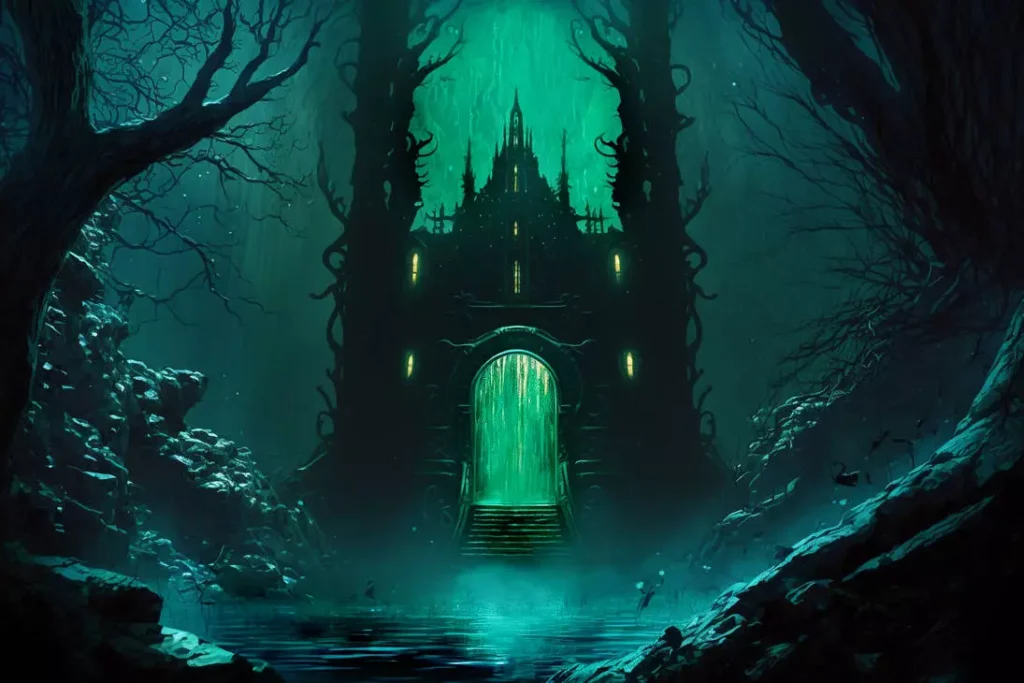Welcome to the A.T.L.A.S. database, your ultimate resource for fantastical and extraordinary things. This entry delves into the chilling realm of the Lich, a fearsome and ancient undead creature from Dungeons and Dragons 5e. Join us as we unveil the mysteries surrounding this malevolent being, providing a detailed description, an overview of its abilities, and an analysis of its threat level.
Basic Description:
The Lich, an abomination borne from the dark arts of necromancy, is a powerful undead entity once a mortal spellcaster seeking immortality. Through vile rituals and forbidden knowledge, they have transcended their mortal form, becoming eternally tied to their phylactery. Cloaked in tattered robes, their flesh decayed and eyes glowing with an otherworldly light, the Lich emanates an aura of death and ancient wisdom. Their skeletal visage and skeletal hands wield unimaginable power, forever trapped in undeath.
Abilities:
Liches possess a formidable array of abilities, making them a nightmarish foe. Their mastery of arcane magic grants them unrivaled spellcasting abilities, capable of wielding devastating spells that manipulate reality. Liches command necromantic forces, raising the dead to serve their dark purposes. Their phylactery, the source of their immortality, allows them to reform their physical form even after being destroyed. Additionally, Liches possess innate knowledge and intellect far surpassing their mortal origins, allowing them to devise intricate plans and outwit their enemies.
Threat Level Analysis:
The threat level of a Lich is extremely high, reflecting their formidable power and undead nature.
With the significantly high Challenge Rating (CR) of 21 in Dungeons and Dragons 5e, Liches are among the most dangerous adversaries.
Their mastery of magic and ability to command legions of undead make them a formidable force in battle. Furthermore, their immortality through the phylactery renders traditional means of defeating undead ineffective. Confronting a Lich requires meticulous planning, powerful magic, and a thorough understanding of their vulnerabilities.
Lich Stat Block
Medium undead, any evil alignment
Armor Class 17
Hit Points 135 (18d8+54)
Speed Walk 30ft.
STR 11 (+ 0)
DEX 16 (+ 3)
CON 16 (+ 3)
INT 20 (+ 5)
WIS 14 (+ 2)
CHA 16 (+ 3)
Saving Throws Str + 0, Dex + 3, Con + 10, Int + 12, Wis + 9, Cha + 3
Skills Arcana +19, History +12, Insight +9, Perception +9,
Damage Resistances cold, lightning, necrotic
Damage Immunities poison; bludgeoning, piercing, and slashing from nonmagical attacks
Senses truesight 120 ft., passive Perception 19
Languages Common plus up to five other languages
Challenge 21 (33,000 XP)
Legendary Resistance (3/Day). If the lich fails a saving throw, it can choose to succeed instead.
Rejuvenation. If it has a phylactery, a destroyed lich gains a new body in 1d10 days, regaining all its hit points and becoming active again. The new body appears within 5 feet of the phylactery.
Spellcasting. The lich is an 18th-level spellcaster. Its spellcasting ability is Intelligence (spell save DC 20, +12 to hit with spell attacks). The lich has the following wizard spells prepared:
- Cantrips (at will): mage hand, prestidigitation, ray of frost
- 1st level (4 slots): detect magic, magic missile, shield, thunderwave
- 2nd level (3 slots): detect thoughts, invisibility, acid arrow, mirror image
- 3rd level (3 slots): animate dead, counterspell, dispel magic, fireball
- 4th level (3 slots): blight, dimension door
- 5th level (3 slots): cloudkill, scrying
- 6th level (1 slot): disintegrate, globe of invulnerability
- 7th level (1 slot): finger of death, plane shift
- 8th level (1 slot): dominate monster, power word stun
- 9th level (1 slot): power word kill
Turn Resistance. The lich has advantage on saving throws against any effect that turns undead.
Actions
Paralyzing Touch. Melee Spell Attack: +12 to hit, reach 5 ft., one creature. Hit: 10 (3d6) cold damage. The target must succeed on a DC 18 Constitution saving throw or be paralyzed for 1 minute. The target can repeat the saving throw at the end of each turn, ending the effect on itself on a success.
Legendary Actions
Cantrip. The lich casts a cantrip.
Paralyzing Touch (Costs 2 Actions). The lich uses its Paralyzing Touch.
Frightening Gaze (Costs 2 Actions). The lich fixes its gaze on one creature it can see within 10 feet of it. The target must succeed on a DC 18 Wisdom saving throw against this magic or become frightened for 1 minute. The frightened target can repeat the saving throw at the end of each of its turns, ending the effect on itself on a success. If a target’s saving throw succeeds or the effect ends, the target is immune to the lich’s gaze for the next 24 hours.
Disrupt Life (Costs 3 Actions). Each non-undead creature within 20 feet of the lich must make a DC 18 Constitution saving throw against this magic, taking 21 (6d6) necrotic damage on a failed save, or half as much damage on a successful one.
Characteristics of Liches
Liches, also known as lichnees, are formidable creatures of undeath, typically originating from spellcasting backgrounds such as wizards, sorcerers, warlocks, or clerics. These skeletal figures, with gaunt frames and decaying flesh, strike fear into the hearts of mortals. Burning red eyes peer through the shadows, and though lacking the necessary organs, liches possess the ability to project speech through powerful magic. They may appear regal in their attire or bear the visage of lepers, but their presence exudes an aura of malevolence.
Liches choose a solitary existence, forsaking mortal connections in pursuit of ultimate magical power and knowledge. Their immortal souls are tethered to the Prime Material plane, enabling them to retain their personalities and emotions, albeit tainted by their transformation into undead beings. While most liches are associated with wickedness due to their detachment from mortal morality, rare instances of good liches with noble intentions have been recorded.
Behavior and Abilities
Liches are avid collectors of arcane secrets and magic items, their insatiable appetite for knowledge matched only by their cunning and insidious schemes. Armed with potent spellcasting abilities, liches can easily cast spells from memory and command their undead minions.
These wicked creatures possess a range of unique abilities, including the manifestation of coldfire, the power to weaken and kill with a touch, the ability to induce unconsciousness through their voice, and the ability to instill fear, pain, or death with a single glance. Life and death are but tools in their hands, allowing them to animate the deceased and exert control over lesser undead creatures.
Liches and Their Environment

Liches establish their lairs in secluded and fortified locations, rarely venturing far from their macabre abodes. These lairs are often protected by creatures subservient to the lich’s will, such as undead, constructs, demons, or devils. They demand absolute loyalty and assistance from these minions, ensuring the security of their sanctuary. Liches have a particular affinity for dark and foreboding places, such as crypts, ancient tombs, or hidden chambers within crumbling ruins.
The Path to Lichdom – How Liches are created
To achieve lichdom, individuals must undergo a purposeful and sinister transformation ritual. This dark and complex process involves the creation of a phylactery, a receptacle that safeguards the lich’s life essence. The ritual requires consuming a toxic mixture made with the blood of an innocent, dealing with dark gods or fiends, and various incantations or blessings. Variations of the ritual exist, with some involving spells, the alignment of celestial bodies, or the favor of malevolent entities like Orcus.
Liches prefer dark and isolated places, such as ancient crypts, hidden dungeons, or cursed ruins, where they can conduct their experiments and delve deeper into forbidden magic.
Confronting a Lich
Confronting a lich is an arduous task that requires careful planning and resourcefulness. Liches excel at manipulating their surroundings and avoiding direct melee combat. They prefer to rely on their minions, an army of undead or cleverly placed traps, to thwart would-be heroes. The resilience of a lich is legendary, as they possess immunity to various spells and effects and radiate an aura of cold and darkness. To permanently destroy a lich, one must locate and destroy its phylactery, a vessel containing its life essence.
Strategies and Examples
Successful encounters with liches often involve exploiting their vulnerabilities and disrupting their well-laid plans. One notable account tells the tale of the renowned paladin Sir Tristan, who faced a lich in the desolate catacombs beneath the ancient city of Eldoria.
Armed with enchanted weapons and a holy symbol capable of dispelling undead magic, Sir Tristan disrupted the lich’s control over its minions and engaged in a battle of wits and might. By swiftly closing the distance and pressuring the lich with relentless attacks, Sir Tristan prevented the creature from casting its most devastating spells. In the final moments of the confrontation, he shattered the phylactery with a consecrated strike, forever ending the lich’s reign of terror.
Countering a Lich
When confronting a lich, knowledge is your most potent weapon. Understanding the creature’s weaknesses and exploiting them is crucial to success. The following strategies have proven effective in combating these powerful undead beings:
- Disrupt their spellcasting: Liches heavily rely on their spellcasting abilities. You can hamper their magical prowess and diminish their advantage by using antimagic fields, spell disruptions, or counterspells.
- Target the phylactery: Destroying a lich’s phylactery is the key to ending its existence. Locate the hidden vessel and take every precaution to neutralize it. Holy rituals, powerful artifacts, or specific spells like disintegrate can aid in obliterating the phylactery.
- Exploit their mortal remnants: Lanes still bear traces of their mortal lives despite their undead state. Researching their past, identifying personal weaknesses, or uncovering long-forgotten memories may provide vital clues to weaken their resolve.
- Unleash divine power: Liches have a vulnerability to divine magic. Calling upon the blessings of deities and channeling divine energy can weaken their defenses and make them susceptible to physical and magical attacks.
Remember, engaging a lich in combat is a perilous endeavor that requires careful planning, powerful allies, and a deep understanding of their arcane abilities. Underestimating a lich’s cunning or falling victim to their illusions can prove fatal.
In Conclusion
Liches are the epitome of undead power, ancient knowledge, and malevolence. Masters of the dark arts seek eternal life and wield formidable magical abilities. To confront a lich is to challenge an immortal being, a creature driven by an insatiable thirst for power and dominion. Only through strategic planning, exploiting weaknesses, and wielding the forces of light and righteousness can these undead tyrants be defeated.
Stay vigilant, dear readers, and remember the mission of A.T.L.A.S.—to study, collect knowledge about, and sometimes eliminate the fantastical creatures that inhabit our world. Knowledge is the key to survival in the face of these formidable adversaries.
Credits
The Lich is a DnD 5e Creature from the Monster Manual. Here are the sources used to create this article
- Take a look at the artwork for the Lich Lair
- Learn More about the Lich
- Here is another undead creature from our Homebrew Library: the Witch King
- Discover more creatures in the Arkane Atlas
 Skip to main content
Skip to main content

